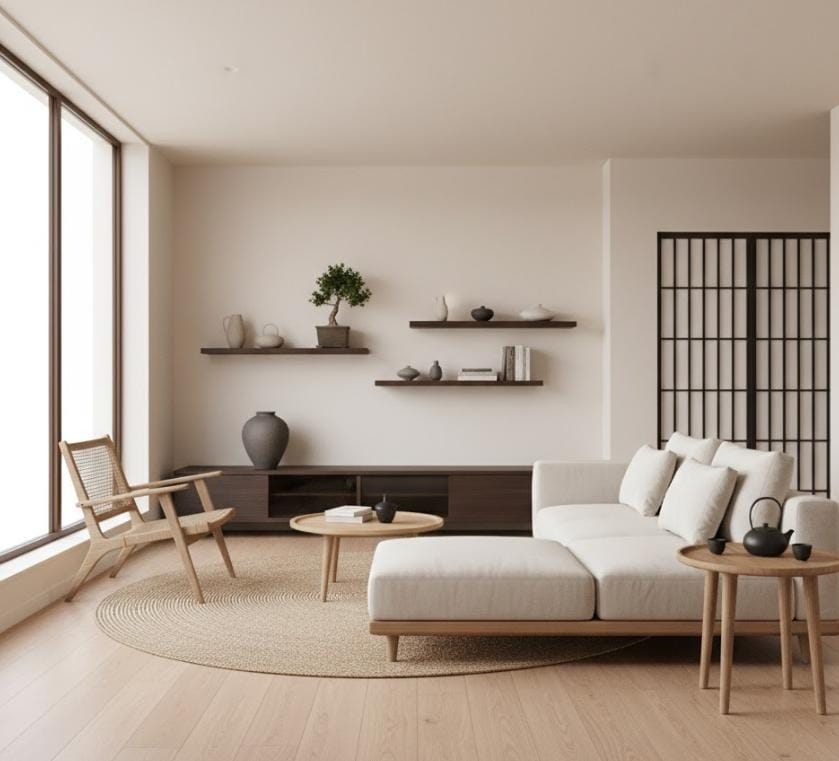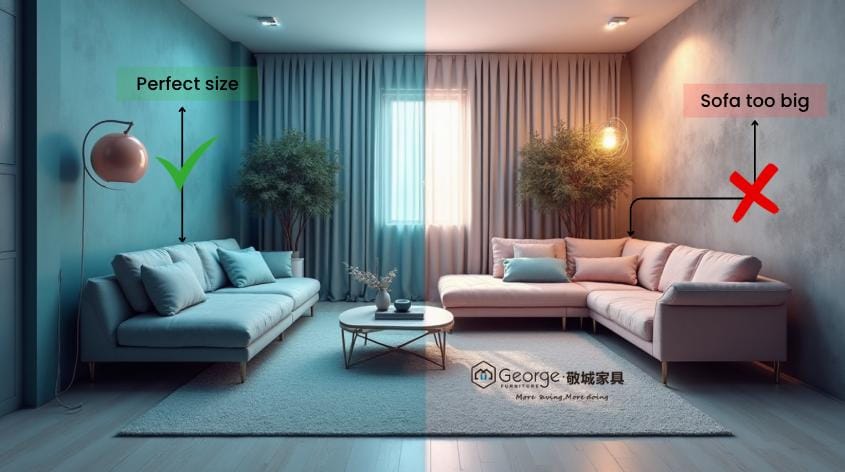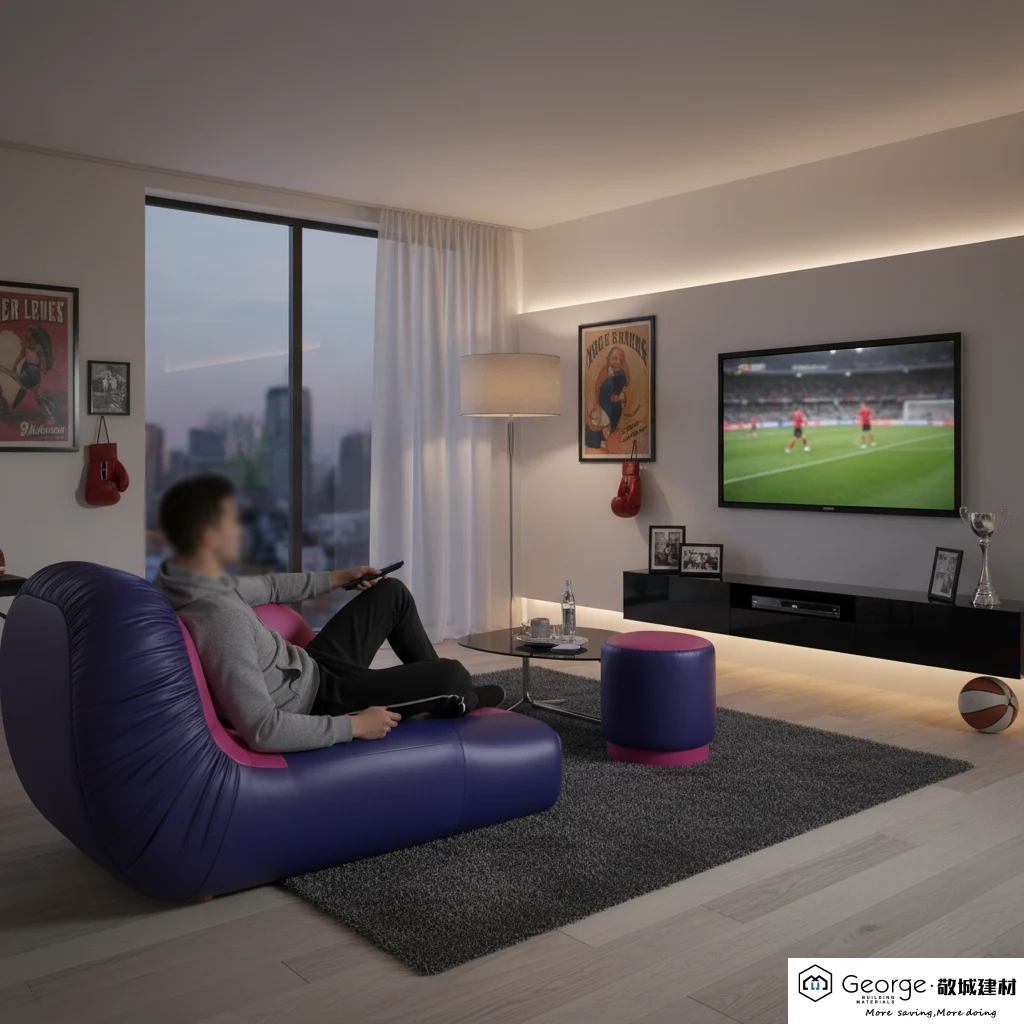
Table of Contents
Are you tired of cluttered spaces? Want a living room that feels both calm and cozy? Then Japandi style might be perfect for you.
Japandi combines the best of two popular design styles: Japanese minimalism and Scandinavian warmth. The result? A living room that’s clean, comfortable, and surprisingly easy to create.
In this guide, I’ll show you exactly how to design your own Japandi living room – even if you’re on a budget or starting from scratch.
Let’s start with the basics.
1. What is Japandi Style?
Japandi mixes two ideas:
From Scandinavia: “Hygge” (say “hoo-gah”) – This means cozy, warm, and comfortable. Think soft blankets and natural wood.
From Japan: “Wabi-Sabi” – This celebrates imperfection. A handmade bowl with a small crack? That’s beautiful in Japandi style.
Together, these create a space that’s minimal but never cold.
So what does this actually look like in your living room? Let me break it down.
The Three Key Features of Japandi Living Rooms
1. Less stuff, more peace
You won’t find lots of decorations here. But it’s not empty or cold. Instead, you’ll see a few carefully chosen pieces that you really love.
2. Light meets dark
Japandi uses light colors (cream, beige, soft gray) as the base. Then it adds small touches of dark colors (black, dark brown) for contrast. This makes the room feel balanced.
3. Low furniture
Most Japandi furniture sits low to the ground. Low sofas, low tables. This makes your ceiling look higher and your room feel more spacious.
Now you might be wondering: “Why should I choose Japandi over other styles?” Good question.
Why Japandi Works for Modern Homes
- Easy to clean: Less clutter means less dusting
- Looks expensive: Even budget pieces look good in this style
- Never goes out of style: This isn’t a trend that will look dated next year
- Works in small spaces: Perfect for apartments
- Reduces stress: A tidy room = a clear mind
Ready to start? First, let’s talk about colors and materials – this is where beginners often get confused.
2. Colors and Materials: Your Foundation

Your Japandi Color Palette (Copy This!)
Main colors (use these most):
- Warm white or cream for walls
- Beige or light gray for your sofa
- Light wood tones (oak, ash)
Accent colors (use sparingly):
- Matte black for picture frames or lamp bases
- Dark brown or charcoal for one piece of furniture
- Soft green from plants
Pro tip: If your room feels too cold, add more beige. If it feels boring, add one dark element (like a black coffee table).
Not sure which beige to choose? Take a photo of your room and compare paint samples in that lighting. Colors look different in every space.
Once you’ve picked your colors, it’s time to choose materials. This is where Japandi really shines.
Materials That Make Japandi Work
Wood (the most important material):
- Light wood: Oak, ash, birch – Use for floors, shelves, table tops
- Dark wood: Walnut, teak – Use for smaller pieces (like a side table)
- Budget option: Pine furniture with a matte finish works great
- What to avoid: Shiny, glossy wood finishes
Price guide:
- Real oak coffee table: $300-800
- Pine alternative: $100-200
- Both work for Japandi!
Fabrics (for comfort):
- Linen curtains and throw pillows
- Cotton or wool blankets
- Jute or wool rugs
- Avoid: Synthetic, shiny fabrics
Stone and natural elements:
- Ceramic pots and vases
- Natural stone coasters
- Clay decorative pieces
- Concrete accents (used sparingly)
Where to shop:
- IKEA (has many Japandi-style pieces)
- Thrift stores (look for wooden furniture you can refinish)
- Online: Wayfair, Article, West Elm
- Local: Pottery studios, furniture consignment shops
Now that you know what to look for, let’s talk about the actual furniture you’ll need.
Quick Reference: Materials and Colors by Element Need a simple checklist? Here’s what to choose for each part of your room:
| Element | Material | Color/Shade | Price Range |
| Flooring | Light wood or bamboo | Beige, honey, bleached oak | $3-8/sq ft |
| Walls | Paint or natural lime | Warm white, sand, soft gray | Technical Details |
| Furniture | Teak, walnut, oak, or ash | Natural wood or dark stain | Varies |
| Fabrics | Linen and cotton | Neutral (cream, beige) or soft pastel | $25-100/piece |
 How to use this table:
How to use this table:
- Start with flooring and walls (your foundation) – Choose furniture in natural or dark wood –
- Add fabrics last for warmth Save this table on your phone when you go shopping!
3. Choosing the Right Furniture

Your Japandi Sofa (The Most Important Decision)
What to look for:
- Height: 30-35 inches tall (lower than regular sofas)
- Color: Beige, light gray, or cream
- Material: Linen or cotton fabric (not leather)
- Shape: Clean lines, rectangular, no fancy curves
- Legs: Wooden legs (light oak or walnut)
Good options:
- IKEA Söderhamn sofa (budget-friendly)
- Article Sven sofa (mid-range)
- Burrow linen sofa (mid to high range)
- Custom linen sofa (splurge option)
Price range: $500 – $2,500
Common mistake: Don’t buy a sofa that’s too small. You want people to actually sit comfortably! A 3-seater is usually the sweet spot.
Once you have your sofa, you’ll need a coffee table. Here’s what works best.
The Perfect Japandi Coffee Table
Size guide:
- Height: 16-18 inches (lower than standard)
- Length: About 2/3 the length of your sofa
- Width: 20-30 inches
Material options:
- All wood (oak, walnut)
- Wood + stone top
- Wood + concrete top
Budget breakdown:
- DIY option: $50-100 (build from pine)
- Budget buy: $150-300
- Quality piece: $400-800
Quick tip: Measure your space first! Leave 14-18 inches between your sofa and coffee table. This gives you space to walk and put your feet up.
Storage Solutions (Keep Clutter Hidden)
The secret to a clean Japandi living room? Everything has a home, and most things are hidden.
Best storage pieces:
- Low sideboard or media console (under your TV)
- Wall-mounted shelves (keep them minimal – 1 or 2 shelves max)
- Storage ottoman (doubles as seating)
- Woven baskets (hide remotes, magazines, toys)
What you DON’T need:
- Big bookcases
- Open shelving units
- Display cabinets
💡Remember: In Japandi style, you display only a few special items. Everything else stays out of sight.
Let’s talk about arranging all this furniture in your actual space.
4. Layout Planning: Where Everything Goes
Japandi Layout Rules (Keep It Simple):
Before you start moving furniture, remember this: Empty space is part of the design. Don’t fill every corner.
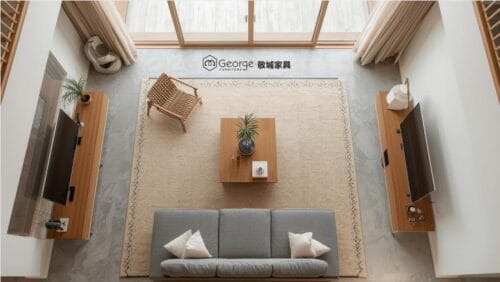
Layout for Different Room Sizes
Small living room (under 150 sq ft):
- One sofa + one coffee table + one small plant
- Wall-mounted shelves (not floor shelves)
- That’s it! Resist adding more.
Medium living room (150-250 sq ft):
- One sofa + coffee table
- One accent chair OR floor lamp
- One rug to define the space
- Small side table
Large living room (over 250 sq ft):
- Full seating area with sofa + accent chair
- Coffee table + side table
- Large rug
- One bookshelf or storage unit
- Reading corner with floor lamp
Pro tip: Take a photo of your empty room. Draw the furniture placement on paper first. This saves hours of pushing heavy furniture around!
Creating Zones Without Walls
You can create different areas in your living room using furniture placement and lighting. No dividers needed.
Conversation area:
- Place your sofa and chair facing each other
- Add coffee table in the middle
- This creates a natural gathering spot
Reading corner:
- One comfortable chair
- Small side table
- Floor lamp
- That’s your quiet zone
TV area:
- Position sofa facing TV (obviously!)
- Keep at least 7 feet between sofa and TV
- Hide cables and equipment in closed storage
Walking paths:
- Leave at least 30 inches for main walkways
- 18-24 inches between furniture pieces
- You should never have to squeeze through
Your furniture is in place. Now let’s add the finishing touches that make it feel complete.
Room Size Planning Guide
Not sure what furniture you actually need? Use this table based on your room size:
| Room Size | Square Feet | What You Need | Layout Tips | Budget |
| Small | Under 150 sq ft | • 1 sofa or loveseat • 1 coffee table • 1-2 plants | Keep walls light and empty. Use wall-mounted storage. One focal point only. | $800-2,000 |
| Medium | 150-250 sq ft | • 1 sofa • 1 coffee table • 1 accent chair OR floor lamp • 1 rug • 2-3 plants | Use rug to define seating area. Leave clear walking paths (30+ inches). | $1,500-4,000 |
| Large | Over 250 sq ft | • 1 sofa + accent chair • Coffee + side table • 1 large rug • 1 storage unit • Reading corner setup • 3-4 plants | Create distinct zones. Use lighting to separate areas. Add dark accents for depth. | $3,000-8,000 |
 How to measure your room:
How to measure your room:
- Measure length and width in feet
- Multiply: Length × Width = Square feet
- Example: 12 ft × 15 ft = 180 sq ft (Medium)
 Don’t know your room size?
Don’t know your room size?
- Walk heel-to-toe across the room –
- Each step ≈ 1 foot
- Count steps for length and width
Now you know what fits in your space. Let’s make it beautiful with the right decorations.
Contact Us for a Project Consultation
Why pay more? At George’s Furniture, we cut out the middlemen to bring you premium furniture, flooring, doors, windows,marble and tiles and more—all at prices up to 40% below retail. With 19+ years of experience and 600 consultants, we provide complete, custom project solutions, from initial design to final delivery.
5. Decorations: The “Less is More” Rule
In Japandi style, you might have 5-10 decorative items total. Compare that to other styles where you might have 30+. This makes shopping easier (and cheaper)!
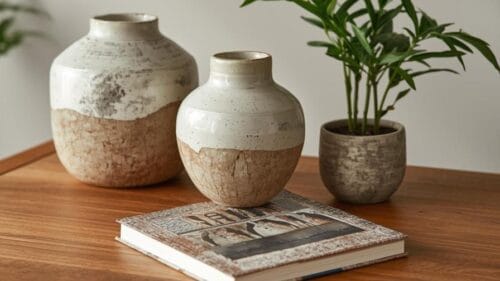
Plants (Choose 1-3 Maximum)
Easy plants for beginners:
- Snake plant (hard to kill)
- Pothos (grows in low light)
- Fiddle leaf fig (if you have bright light)
- Bamboo in water (very Japandi)
- Monstera (for dramatic look)
Where to put them:
- One large plant in a corner
- One small plant on your coffee table
- One hanging plant (optional)
Pots: Use simple ceramic pots in white, beige, or terracotta. Avoid colorful or decorative pots.
Price: $15-50 per plant
Care tip: Water when the top inch of soil is dry. Most people kill plants by overwatering, not underwatering!
Decor Shopping List (Buy Only What You Need)
☐ One ceramic vase – For dried flowers or branches ($20-50)
☐ One decorative bowl – For your coffee table ($15-40)
☐ 2-3 woven baskets – For hidden storage ($30-60 total)
☐ One handmade ceramic piece – Mug, plate, or small sculpture ($25-80)
Where to buy:
- Etsy (search “ceramic japandi”)
- Local pottery studios
- HomeGoods or TJ Maxx (budget option)
- West Elm (mid-range)
What NOT to buy:
- Colorful decorations
- Anything with busy patterns
- Metal/shiny objects
- Plastic anything
- Word signs (“Live, Laugh, Love” – no!)
Textiles: Adding Warmth Without Clutter
Your Japandi rug:
- Size: Should extend 12-18 inches beyond your sofa on all sides
- Material: Jute, wool, or cotton
- Color: Cream, beige, or soft gray
- Pattern: None, or very subtle geometric
- Price: $150-600 depending on size
Good rug brands:
- Ruggable (washable, good for kids/pets)
- West Elm
- IKEA (budget option – their LOHALS jute rug is perfect)
Throw pillows (buy 3-5):
- Linen in cream or beige
- Different sizes: mix 20×20″ and 16×16″
- Different textures: smooth linen + chunky weave
- Price: $25-60 each
Throw blankets (buy 1-2):
- Chunky knit or waffle weave
- Neutral colors (cream, oatmeal, light gray)
- Drape casually over sofa arm
- Price: $40-100 each
Window treatments:
- Linen curtains in white or cream
- Floor length (they should just touch the floor)
- Simple rod in matte black or wood
- No fancy patterns or valances
Wall Art (Keep It Minimal)
The rule: One large piece OR a small gallery (2-3 pieces max)
What works:
- Abstract art in neutral colors
- Black and white photography
- Line drawings
- Japanese calligraphy prints
Frame style:
- Thin frames in black, dark wood, or natural wood
- No ornate gold frames
- No thick chunky frames
Hanging tips:
- Center of art should be at eye level (about 57-60 inches from floor)
- Leave lots of empty wall space
- Don’t fill every wall
Budget options:
- Print your own from free sites (Unsplash, Pexels)
- Frame fabric or pressed plants
- DIY abstract art with paint samples
Now let’s talk about lighting – this is what brings everything together.
Contact Us for a Project Consultation
Why pay more? At George’s Furniture, we cut out the middlemen to bring you premium furniture, flooring, doors, windows,marble and tiles and more—all at prices up to 40% below retail. With 19+ years of experience and 600 consultants, we provide complete, custom project solutions, from initial design to final delivery.
6. Lighting: Creating the Right Mood
Good lighting can make even budget furniture look expensive. Bad lighting makes everything look cheap. It’s that important.

Maximizing Natural Light
First priority: Let in as much daylight as possible.
- Keep windows clean (do this monthly)
- Use light, sheer curtains
- Don’t put tall furniture in front of windows
- Add a mirror across from a window (doubles the light)
Lighting Layers (You Need All Three)
1. Ambient lighting (general light):
- Ceiling light with dimmer switch
- Warm white bulbs (2700K-3000K)
- Avoid harsh overhead lights
- Budget: $50-200
2. Task lighting (for reading):
- Floor lamp next to sofa or chair
- Adjustable arm is helpful
- Examples: IKEA Ranarp, Target Threshold collection
- Budget: $50-150
3. Accent lighting (mood):
- Table lamp on side table
- Candles (real or LED)
- String lights are OK if minimal
- Budget: $30-100
Total lighting budget: $130-450
Quick test: Turn on all your lights at night. Does it feel cozy or harsh? If harsh, you need warmer bulbs or dimmer switches.
Best Japandi Light Fixtures
Pendant lights:
- Paper lanterns (Noguchi-style)
- Woven rattan shades
- Simple geometric shapes
- Price: $80-300
Floor lamps:
- Tripod base in wood
- Arc lamp in matte black
- Rice paper shade
- Price: $70-250
Table lamps:
- Ceramic base in neutral color
- Linen shade
- Wood and metal combination
- Price: $50-150
Where to buy:
- IKEA (great budget options)
- Target (Project 62 line)
- West Elm
- CB2
Pro tip: Put all your lamps on the same warmth bulbs (2700K). Mixed color temperatures look messy.
Now let’s talk about mistakes to avoid.
7. Common Problems (And How to Fix Them)
Problem 1: “My room looks boring”
Symptoms: Everything is beige, feels flat
Fix:
- Add one dark element (black frame, dark wood table)
- Bring in texture (chunky knit blanket, jute rug)
- Add one large plant
- Make sure you have all three lighting layers
Problem 2: “I can’t afford expensive furniture”
Symptoms: Looking at $2,000 sofas, feeling stuck
Fix: Start with these basics:
- Paint walls warm white ($50)
- Buy linen curtains ($60-100)
- Add plants ($45 for 3 plants)
- Get throw pillows ($75 for 3)
- Total: $230-270
Then buy one good piece per month instead of everything at once. It’s OK to take 6 months to fully furnish your room.
Contact Us for a Project Consultation
Why pay more? At George’s Furniture, we cut out the middlemen to bring you premium furniture, flooring, doors, windows,marble and tiles and more—all at prices up to 40% below retail. With 19+ years of experience and 600 consultants, we provide complete, custom project solutions, from initial design to final delivery.
Problem 3: “My space is too small”
Symptoms: Room feels cramped, can’t fit standard furniture
Fix:
- Use wall-mounted shelves instead of bookcases
- Choose a loveseat (60″) instead of full sofa (80″+)
- Skip the coffee table, use nesting tables instead
- One large mirror makes space feel bigger
- Keep only 1-2 accent pieces
Problem 4: “It looks too cold/minimal”
Symptoms: Feels like a showroom, not comfortable
Fix:
- You need more textiles! Add 2 more throw pillows and a blanket
- Make sure your lighting is warm (not cool white bulbs)
- Add a second plant
- Layer your rug (jute rug with smaller accent rug on top)
- Display one personal item (photo, special object)
Problem 5: “I have kids/pets – is this realistic?”
Symptoms: Worried about keeping it clean and minimal
Yes! Here’s how:
- Choose washable rug (Ruggable is perfect)
- Use lidded baskets for toy storage (hide at end of day)
- Pick durable fabric for sofa (tight-weave linen or cotton)
- Set up one catch-all basket for daily clutter
- Accept some imperfection (very Wabi-Sabi!)
- Choose darker accent chair (hides stains better)
Problem 6: “My partner thinks it’s too plain”
Symptoms: They want more color/personality
Fix:
- Keep the base neutral, add subtle color through art
- Let them choose one accent piece in darker color
- Add texture through different materials
- Show them finished room photos (not individual pieces)
- Compromise: One shelf for their collectibles, rest stays minimal
Problem 7: “Everything in stores looks too modern or too traditional”
Symptoms: Can’t find the right Japandi pieces
Fix:
- Mix sources: IKEA + vintage + handmade
- Look for clean lines (modern) in natural materials (traditional)
- Buy unfinished wood furniture and finish it yourself
- Check Facebook Marketplace for solid wood pieces
- Paint existing furniture in neutral colors
8. Step-by-Step Shopping Guide
Not sure where to start? Follow this order:
Month 1: Foundation ($500-1,200)
- Paint walls – Warm white or cream ($50-100)
- Curtains – Linen or light cotton ($80-150)
- Rug – Jute or wool, proper size ($150-400)
- Plants – 2-3 low-maintenance ($40-100)
- Storage baskets – 2-3 woven ($50-100)
Total: $370-850
Month 2: Main Furniture ($500-2,000)
- Sofa – Your biggest investment ($500-2,000)
Wait! Don’t buy anything else yet. Live with just this for a few weeks. See what you actually need.
Month 3: Supporting Furniture ($300-800)
- Coffee table – Low, wood or wood/stone ($150-500)
- Side table – Small, simple ($50-150)
- Floor lamp – Warm light, natural materials ($80-200)
Month 4: Comfort Layer ($200-400)
- Throw pillows – 3-5 in linen ($75-200)
- Throw blanket – Chunky knit or waffle ($60-120)
- Table lamp – For side table ($50-100)
Month 5: Final Touches ($100-300)
- Wall art – 1-2 pieces ($50-150)
- Decorative items – Vase, bowl, ceramics ($50-150)
Total Investment:
- Budget: $1,470-3,350
- Mid-range: $2,500-5,000
- High-end: $5,000-10,000+
Money-saving tips:
- Buy big furniture pieces first, decor last
- Mix IKEA with higher-end pieces
- Check thrift stores for wood furniture
- DIY your art and some textiles
- Wait for sales (West Elm has good ones)
9. Maintenance: Keeping It Japandi
The beauty of this style is that it’s easy to maintain. Here’s your routine:
Daily (5 minutes)
- Put items back in their homes
- Fluff sofa cushions
- Wipe coffee table if needed
Weekly (15 minutes)
- Dust surfaces with microfiber cloth
- Vacuum or sweep floor
- Water plants
- Put away items that don’t belong
Monthly (30 minutes)
- Deep clean rug
- Wash throw pillow covers
- Trim plant leaves
- Wipe down all wood furniture
- Assess: Does anything need to be removed?
Seasonally (1-2 hours)
- Wash curtains
- Rotate rug to prevent wear
- Deep clean behind furniture
- Switch out throw blanket for season
- Declutter: Remove items you haven’t used
💡The one-in-one-out rule: Every time you bring something new into your living room, remove something old. This keeps clutter from building up.
Frequently Asked Questions
Q: How much does it cost to create a Japandi living room?
A:
- Budget option: $500-1,000 (IKEA + thrift stores)
- Mid-range: $2,000-4,000 (mix of retailers)
- High-end: $5,000-10,000+ (custom pieces)
Start with the budget option and upgrade pieces over time.
Q: Can I mix Japandi with my existing furniture?
A: Yes! Start by:
- Painting walls a neutral color
- Adding Japandi accessories (pillows, plants, art)
- Removing excess decorations
- Slowly replacing furniture as budget allows
Your existing wood furniture probably works fine if you paint or refinish it.
Q: What’s the difference between Japandi and regular minimalism?
A: Regular minimalism can feel cold and stark. Japandi adds:
- Warmth through natural materials
- Coziness through textiles
- Character through handmade items
- Balance through light + dark contrast
Think “minimal but cozy” not “minimal and cold.”
Q: Where do I start if I’m overwhelmed?
A: Start here, in this order:
- Declutter everything (be ruthless)
- Paint walls warm white
- Add linen curtains
- Get 1-2 plants
Do this before buying any furniture! You’ll have better clarity on what you actually need.
Q: Is Japandi good for renters?
A: Perfect for renters! You don’t need to make permanent changes. Focus on:
- Furniture (you’ll take it with you)
- Rugs (portable)
- Curtains (easy to install and remove)
- Plants and decor
- Removable peel-and-stick wallpaper (if needed)
Skip: Built-in shelving, wall paint (unless allowed)
Q: How do I maintain a Japandi living room?
A: It’s actually easier than other styles:
- Declutter weekly (10 minutes)
- Dust with microfiber cloth (less stuff = less dusting)
- Rotate throw pillows to prevent wear
- Trim plants monthly
- Follow the one-in-one-out rule
The minimal nature means there’s less to maintain!
Q: Can Japandi work in a dark room?
A: Yes, but you’ll need to:
- Use lighter wood tones (oak vs walnut)
- Add more warm lighting layers
- Use mirrors strategically
- Keep walls very light (bright white)
- Avoid dark accent colors
- Add more plants near light source
Q: What if I like color?
A: You have options:
- Add color through art (muted tones work best)
- Use plants for natural green
- Choose one accent chair in darker sage or terracotta
- Add colored spine books on minimal shelf
- Burnt orange or deep green pillow (just one!)
Keep it subtle. Japandi isn’t about zero color, just restrained color.
Q: How is this different from Scandinavian design?
A:
- Scandinavian: All light colors, very bright, more decorative
- Japandi: Mix of light and dark, more minimal, celebrates imperfection
- Scandinavian: Symmetrical arrangements
- Japandi: Asymmetrical, more organic placement
Q: Where can I see real Japandi living rooms for inspiration?
A: Check these out:
- Instagram: #japandiliving #japandilivingroom
- Pinterest: Search “japandi living room”
- YouTube: Room tours
- Design blogs: Apartment Therapy, Design Milk
- Brands: Muji, IKEA (some collections), West Elm
Q: Can I DIY any Japandi furniture?
A: Absolutely! Easy DIY projects:
- Coffee table from wood slabs + hairpin legs
- Floating shelves
- Plant stands
- Throw pillows (sew linen covers)
- Frame your own art
- Refinish thrifted wood furniture
✅ Remember These Japandi Rules:
- Japandi is about living with less but better
- Don’t rush – Choose pieces you truly love
- Quality over quantity – One great sofa beats three cheap ones
- Embrace imperfection – Wabi-Sabi means it doesn’t have to be perfect
- Make it yours – Follow the principles, but add what makes you happy
Still have questions?
- Save this guide for reference
- Share with friends designing their spaces
- Start with small changes and see what feels right
Final thought:
The best Japandi living room is one you actually use and enjoy. Don’t create a museum – create a space where you want to spend time.
For high-quality natural materials like sustainable oak, walnut, and natural stone surfaces, George’s Furniture offers curated selections specifically for Japandi interior projects worldwide.


 Don’t know your room size?
Don’t know your room size?